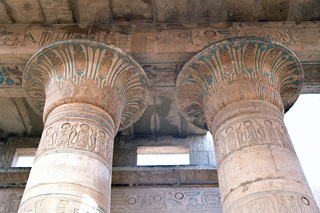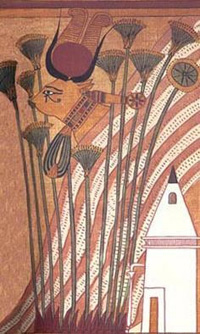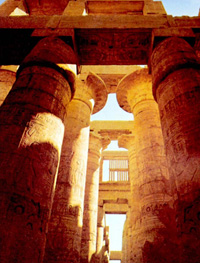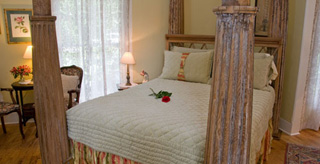Human Flower Project
In Architecture, Ancient Plants Grow
Russell Bowes looks back several thousand years to the papyrus, palms, lotus and acanthus still rooted in the world’s building styles.

Stylized papyrus blooms top columns
Ramesseum—Luxor, Egypt
Photo:via wiki
By Russell Bowes
Ornamentation of a building is not strictly necessary. Doors, windows and walls function just as well plain as decorated. Yet for thousands of years, people have turned the structural parts of buildings into naturalistic and stylised depictions of local plants and flowers.
Was this for the joy in decorating plain surfaces? Or did the leaves and fruits have deeper meaning? Perhaps ancient buildings speak to us in a language we no longer hear, with words we no longer understand.
 Goddess Hathor stalks through papyrus plants, from Papyrus of Ani
Goddess Hathor stalks through papyrus plants, from Papyrus of Ani
Photo: via wiki
The earliest Egyptian builders worked in a landscape inhospitable to trees. Thin soil, negligible rainfall and constant desert winds don’t support large stands of timber; thus, buildings constructed entirely of wood were extremely rare. In the millennia before the widespread use of stone as a building material, with wood at a premium and with relatively crude hand tools unsuitable for working what little timber was available, the ancient Egyptians used more abundant materials which were more workable with the tools they possessed.
The Egyptians staple building material was made from bundles of reeds, woven with palm fronds for added tensile strength and liberally smeared with layers of mud from the Nile. Palm leaves, however, are not completely flat but curve at the tip, and these curved tips were often left poking free of the structure at the tops of walls, forming a curved ‘architrave’ between the uppermost section of the wall and the roof. In centuries to come, when walls were made of stone blocks, this curve would be translated into stone, becoming the cavetto cornice which is such a distinctive feature of Egyptian architecture. Often painted to resemble a row of palm fronds, they served constantly to remind the later Egyptians of their architectural heritage.

Cavetto cornice, 204 Allen St., Buffalo, NY
Photo: Buffalo as an Architectural Museum
Wattle and daub, however, was not strong enough to support the roofs of later, larger buildings, structures with much longer walls than crude huts. Bundles of papyrus stems, which have a hollow structure similar to bamboo, were lashed together and interspersed with the wall panels or used as freestanding supports, although they also tended to splay at the top under the weight of the roof timbers. A crude column, complete with rudimentary ‘capital’ had been born. Again, when these columns were later rendered in stone, allowing buildings to become progressively higher, the architects copied the entire form of what had gone before—including the papyrus bindings. The column shaft was lobed in a literal translation of the bundle of stems, while the capital came to represent the closed buds of the papyrus flower.
In a society where practically everything had a symbolic meaning as well as a practical use, the closed buds came to represent “night”. Columns representing a single papyrus stem, with a fully opened flower—symbolising day and the rebirth of the sun god Ra—began to appear during the reign of the Pharaoh Amenotep III (1390 – 1353 BC). Similarly, the lotus column derived its form from a bundle of stems surmounted by closed flower buds. (It should be noted that ‘lotus’ refers to the white waterlily (Nymphaea lotus), from which the sun disc was, according to Egyptian belief, reborn each morning, and not the true lotus (Nelumbo sp.) which is not native to Egypt.) Both lotus buds and open flowers feature prominently in the capitals of composite columns, as do the flowers and buds of the papyrus.
 Hypostyle Hall, Temple of Karnack
Hypostyle Hall, Temple of Karnack
Photo: Artlex
All Egyptian architecture was of ‘post and lintel’ form, composed entirely of vertical and horizontal planes; the load-bearing capabilities of the arch would not become widely known for many hundreds of years. Because stone is stronger molecularly as a post than a beam, large numbers of columns were necessary to support comparatively narrow roof spans. This lead to the development of great hypostyle halls in the larger temples. With their brightly coloured lotus and papyrus columns, they represented the primeval swamp from which Hathor, the cow goddess, walked on the first day of creation. For the privileged few who could enter these halls, the architecture symbolized life’s beginnings of life, as humankind crawled from the mud beneath the sacred waters of the Nile.
Farther north, the climate of the Mediterranean coast, with richer, deeper alluvial soil and measurable rainfall, supported the growth of palm trees of sufficient size, strength and quantity to make them a viable building resource. Sacred to Ra, the palm was initially honoured not by a literal representation of the tree in stone, in the form of a column, but by binding palm fronds to a tall wooden stake, used decoratively to line processional routes and temple precincts. Again, the rope bindings were clearly copied when the wooden ‘trees’ became stone columns. A stone abacus block took the downward thrust of the roof rather than the ‘palm fronds’ themselves. Thus the plant determined only the form of the stone column it gradually became and not its supporting function within the structure.
 The oak, Jupiter’s tree
The oak, Jupiter’s tree
Image: Alciato Book of Emblems
More temperate regions of the Grecian plains were more densely wooded also. Different species of tree were sacred to particular gods of the pantheon (the oak to Jupiter, the bay to Apollo) as well as the home of dryads (tree spirits) who cared for each tree and ensured its fruitfulness. Through their roots and branches, trees connected the earthly plane of human existence with the underworld and the heavens. In tribute to their deities, the ancient Greeks honoured the trees themselves – individually, as a single specimen, or collectively in the form of a holy grove. A grove may have been roped off to indicate its special status, and offerings of flowers and fruit were hung between the trees from ropes secured to the branches. It is not difficult to see the connection between tree trunks and columns, and thus between a sacred grove and a temple made of stone. Likewise, the swags of offerings were eventually translated into applied decoration, rendering the tribute permanent rather than transitory.
Once the grove of trees had been made permanent by reproducing trunks as columns, attention focussed on decorative treatments of their tops. It is not difficult to see the twin spirals (volutes) of the Ionic capital as representing the tight curl of an opening shoot, or a coiled stem [pic 9]. The most decorative architectural order was the Corinthian, the form most enthusiastically adopted by the flourishing Roman Empire. Although many variants of the style are known, the principal component was the acanthus leaf, symbol of death and rebirth. Both Acanthus spinosus and Acanthus mollis were represented. Being an herbaceous plant, the acanthus is an ideal symbol of regeneration.
 Corinthian columns, Library of Congress, Washington, D.C.
Corinthian columns, Library of Congress, Washington, D.C.
Photo: Classical Traditions/Vanderbilt Univ.
Additionally, a popular legend added credence to the theme of resurrection. [pic 10] A young girl of Corinth died and her mother gathered together some of her daughter’s favourite possessions in a basket. Covering this with a tile to keep out the rain, she laid it on the child’s grave but in her grief failed to notice that she had placed it on a dormant crown of acanthus. The following spring, the newly emerging leaves pushed out from the soil and grew up around the basket. A passing architect, Callimachus, saw the basket enveloped by foliage and was inspired to use the composition as a column capital. A nice story, but one which will never be proved, unfortunately,
Usually Corinthian capitals were purely foliate, consisting of leaves of acanthus and other species. However, a variation, popular in central and northern Europe from around 2AD, shows faces peering down from the capitals, recalling the Greek idea of trees being inhabited by gods and dryads. [pic 11] Known as Jupiter Capitals, they may well have contributed to the popularity of the ‘Green Man’ mythology, a pagan deity of vegetation and symbolic of the links between the kingdoms of the plants and man. There was also limited use of the heavily stylised palm capital, showing that first the Greeks and then the Romans were not above borrowing ideas they found aesthetically pleasing.
The native flora of Egypt and Greece profoundly influenced the buildings each culture created. The effects were both stylistic and symbolic, with each country’s buildings honouring their gods and paying homage to indigenous creations myths. The Romans, having subsumed the forms of Greece into their own culture, with sometimes little or no understanding of the ideas that lay behind them, exported their adopted architectural styles around their empire. The use of the principal elements, in decorative terms, reappeared throughout time and around the world.
 Bed with columns
Bed with columns
Photo: Chloe’s Garden Room
We continue to adorn our great public buildings with plant motifs and images which have little, if any, relevance or meaning for us today. But we feel comfortable with them, and unconsciously feel that a building in classical style is somehow more ‘solid’ in character than one without the familiar architectural references. It may be that, although the words have lost their original meanings, and the language is one which we no longer understand, the buildings still speak to us of the virtues of the past. Through the plant forms, obvious or disguised, that adorn our buildings, we continue to hear the messages spoken by our ancestors. We may no longer understand, but we are still listening.
Russell Bowes is a garden historian and lecturer, based in London. He’s generously appended a bibliography to this essay. Thank you, Russell.
Selected Sources
Anderson, W. Green Man (HarperCollins, 1990)
Fleming J., Honor, H., and Pevsner, N. Dictionary of Architecture (Penguin, 1991)
Gibberd ,V. Architecture Source Book (MacDonald Orbis, 1988)
Howarth, E. Crash Course in Architecture (Headline, 1990)
Lawrence, A.W. Greek Architecture (Yale University Press, 1957)
Lloyd, S. and Müller, H.W. Ancient Architecture (Faber and Faber, 1986)
Seton-Williams, V. and Stocks, P. Blue Guide: Egypt (A&C Black, 1993.
and Stocks, P
Wildung, D. Egypt: From Prehistory to the Romans (Taschen, 1997)
Woodbridge, S. Details: the Architects Art (Chronicle Books, 1991)
Yarwood, D. A Chronology of Western Architecture (Batsford, 1987)


I heart “classical” architecture. Now Russell has provided a possible reason: subconsciously I have been responding to plant-based forms.